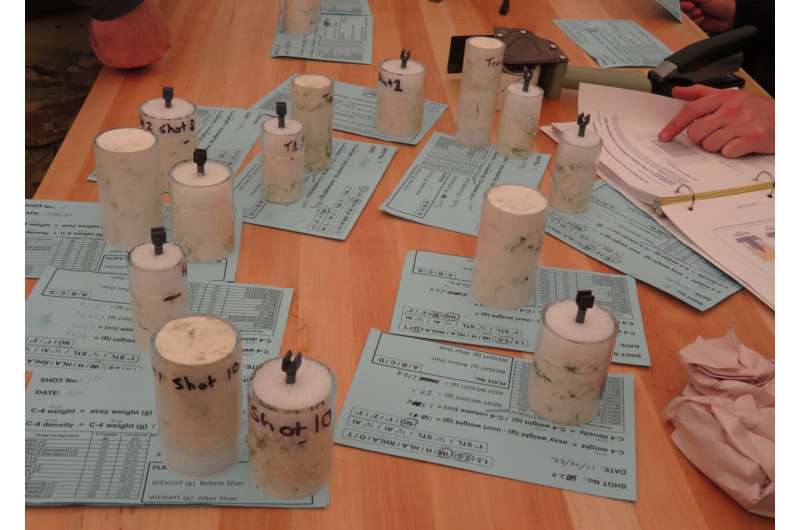
Lawrence Livermore National Laboratory (LLNL) scientists and engineers led a multi-institutional team in executing a series of high explosives tests that successfully demonstrated fundamental principles of anisotropy, a possible enabler for improved weapon and munition safety.
Working under snowy and frigid conditions on Idaho’s Snake River Plain, a 13-member team from LLNL carried out 52 explosives shots over four days in mid-November at the Idaho National Laboratory’s (INL) National Security Test Range (NSTR) to complete the study. The broader anisotropy (ANISO) team included high explosives handlers and volunteers from INL, Los Alamos National Laboratory, Marine Raiders from the Marine Special Operations Command and members of the U.S. Special Operations Command.
The purpose of the study was to explore theoretical methods of creating anisotropic explosives—explosives that perform differently depending on the direction the detonation wave moves through the explosive—by engineering certain physical features in the charges and obtaining basic data from testing.
The work is part of an overall effort by the Lab to develop anisotropic explosives that could be used in munitions to reduce the severity and lethality of an unintended detonation without sacrificing performance. The data gathered from the study will be used to design and construct follow-on experiments at LLNL’s High Explosives Applications Facility (HEAF) and validate computer models for future anisotropic assemblies.
“This experiment served as an example of an expedient and efficient means of evaluating a new theoretical concept,” said Mark Hart, a scientist and engineer in LLNL’s Defense Technologies Engineering Division and the study’s strategic technical program manager. “In this experiment, anisotropy was demonstrated with detonation performance dependent on the direction of the detonation wave. Conceivably, explosive munitions could be designed using anisotropic explosives to be less damaging and less lethal during an accidental or unintentional detonation.”
Without a design to start from, a small team at LLNL worked nights and weekends, and off-hours over a span of eight weeks to prepare for the tests, designing, machining and preparing the hundreds of pieces of hardware and equipment needed to carry out the operations. The team crated and shipped the hardware to INL’s NSTR, and once unloaded, the study was a “seamless operation,” Hart said.
“Everyone brought their own special skills to the table,” Hart said.
Hailing from different parts of the country and representing a variety of disciplines, including data science, the ANISO team members met for the first time during a pre-job briefing on Nov. 13. The following morning, six high explosives handlers quickly went to work, simultaneously packing 20 small, linerless C-4 shaped charges of different designs and firing them on the range later that day.
Over the course of three days, the team assembled and detonated a series of designs, firing strings of linerless shaped charges forward and backward, to narrow down which were most likely to demonstrate anisotropic behaviors. The initial tests provided researchers with valuable information on the assemblies’ performance and behavior and enabled the team to create and fire six proof-of-principle shots on the study’s fourth and final day, demonstrating—for the first time on a macroscopic scale—the principle of anisotropy.
Using high speed cameras, the team captured video of the detonations moving in forward and backward directions through a series of eight linerless shaped charges with various gaps between them and compared the results. The videos clearly showed the detonations moved through the assembly faster in one direction and slower in the opposite direction, confirming that high explosive performance could be engineered to vary based on physical features built into the explosive and the direction of the detonation wave moving through the explosive.
In addition to aiding design and construction of assemblies for testing in HEAF’s 10-kilogram tank, the data from the study will be used to develop and validate artificial intelligence and machine learning-backed computer simulations that can predict performance and help design bulk anisotropic explosive charges.
Citation:
Research team demonstrates anisotropic explosive properties in key weapon safety study (2023, January 27)
retrieved 27 January 2023
from https://techxplore.com/news/2023-01-team-anisotropic-explosive-properties-key.html
This document is subject to copyright. Apart from any fair dealing for the purpose of private study or research, no
part may be reproduced without the written permission. The content is provided for information purposes only.
Stay connected with us on social media platform for instant update click here to join our Twitter, & Facebook
We are now on Telegram. Click here to join our channel (@TechiUpdate) and stay updated with the latest Technology headlines.
For all the latest Technology News Click Here
For the latest news and updates, follow us on Google News.
